April 25, 2008 (Bloomberg) — The poop hit the fan when the last manure mulcher in Los Angeles closed shop.
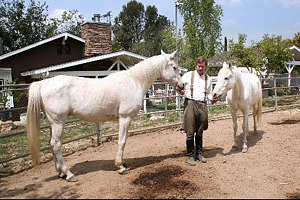
Fritz Bronner, a local horse owner and activist, feeds two of his five Arabian geldings in the corral behind his house in the Lake View Terrace neighborhood of Los Angeles on April 8, 2008. Los Angeles is home to some 1,500 legally registered horses, but the actual count is more like 10,000, according to Los Angeles City Councilwoman Wendy Greuel. Photographer: Nadja Brandt/Bloomberg News |
The price of poop disposal is breaking the budgets of Los Angeles horse owners, as stable owners pass along the expense of taking horse droppings to landfills.
“The cost to get rid of this stuff has just skyrocketed,” said Royan Herman, 65, who runs the Peacock Hill and J-Bar Ranch stables in the San Fernando Valley with her husband, Mark. “A lot of young families aren’t able to afford a horse anymore.”
Los Angeles, the city of Hollywood stars, is also home to about 10,000 horses, said City Councilwoman Wendy Greuel. Some estimates of the horse population run as high as 20,000 within city limits and 45,000 in all of Los Angeles County, which has 9.9 million residents.
The waste produced by horses living in a big city wasn’t a problem for decades, as plant nurseries and compost yards accepted manure and turned it into fertilizer. When zoning officials allowed developers to build homes close to those sites, new residents complained of the stench and nurseries began turning away the dung. The owner of the last compost yard, Dickran Sarkisian, said he closed in October because he wasn’t able to renew the lease.
Depositing manure at a landfill costs as much as $47 a ton, five times what the mulchers charged, said Mark Herman of Peacock Hill and J-Bar. Stable owners can’t afford to stay in business unless they pass that expense to boarders, he said.
“In the last four to five years, the cost for individual horse owners has doubled,” said Herman, 85. He said the 120 horses at his stables produce as much as 5 tons (4.5 metric tons) of manure a day.
Equine Surrender
Some Angelenos said the rising stable fees are forcing them to give up their beloved horses.
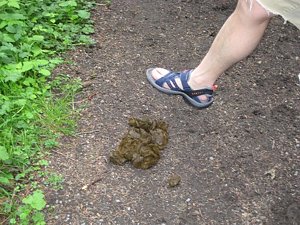 “The prices for boarding a horse are crazy,” said Rachel Rosenberg, 24, an aspiring actress who keeps her mustang, Indie, at Ravensview Ranch. “If I don’t get enough hours together at work, I won’t be able to afford him.”
“The prices for boarding a horse are crazy,” said Rachel Rosenberg, 24, an aspiring actress who keeps her mustang, Indie, at Ravensview Ranch. “If I don’t get enough hours together at work, I won’t be able to afford him.”
Jack Quigley, a retired oil field production technician, already had to sell his mare, Fancy.
“I loved her to death,” said Quigley, 67. “But I couldn’t afford to keep her.”
Barbara Underwood, 65, who owns Ravensview, a 27-horse stable near Burbank, said she lost eight boarders when she raised prices. She charges $300 a month for a small corral and $400 for a box stall, following the $15 increase in December. She expects to boost rates again soon, by $20.
At Peacock Hill and J-Bar, Royan Herman said she may have to raise fees by $100 from the current $300 to $450 a month.
Riding Territory
Los Angeles offers plenty of space and varied terrain for riding. The county encompasses 4,000 square miles (10,000 square kilometers), including a 70-mile (110-kilometer) Pacific Ocean coastline, mountains, forest and desert.
Some horse-friendly enclaves cater to riders. In Lake View Terrace, a dry cleaner has a hitching post, and street-crossing buttons at some intersections are at a height where they can be reached from horseback.
“It’s this incredible feeling of being in a different world,” said Fritz Bronner, 49, riding Faz, one of his five Arabian geldings, on one of Lake View Terrace’s bridal paths. “All along my street, there are horses and chickens and dogs. It’s a little country feel on a half acre.”
Much of the Los Angeles horse population is off the books. Only about 1,500 are registered, which is required by law, according to city officials.
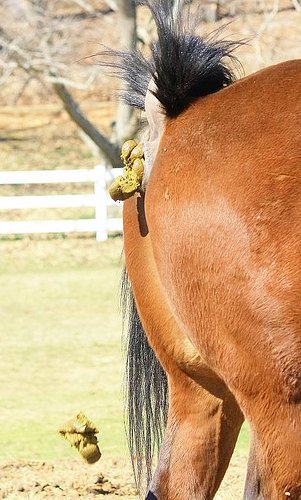 Registration Drives
Registration Drives
That doesn’t help the equine community’s cause, said Greuel, the councilwoman. She’s pushing for a Horse Advisory Task Force to get more owners to comply, so they’ll have a bigger voice in municipal affairs.
Some residents including formed “poop councils” and staged registration drives to educate owners and encourage them to sign up their animals for $14 a year.
“I’ve never even heard of registering your horse,” said Sari Sarlund, 41, who boards her Frido at the Los Angeles Equestrian Center.
Horses generate an estimated $900 million in ancillary revenues a year, Bronner said, sustaining riding teachers, veterinarians, blacksmiths, and feed and tack stores. Bronner, an actor, runs a non-profit service that provides Arabian horses for military re-enactments, parades, films and television.
“It’s an underground economy,” said Bronner, who serves on the Foothill Trails Neighborhood Council. “We never get credit for it. It’s never properly accounted for.”
Poop could add even more cash to city coffers. Councilman Richard Alarcon started a pilot program to recycle some of the manure into compost.
“We are looking at every option available to us, including the generation of electricity,” Greuel said.
Bronner said he’s worried that the poop-disposal crisis and lack of political clout may spell an end to the intangible benefits of sharing Los Angeles with horses.
“The clip-clop on the streets is soothing,” Bronner said. “Horses just slow everything down a bit. Traffic slows down, you slow down.”
To contact the reporter on this story: Nadja Brandt in Los Angeles at nbrandt@bloomberg.net
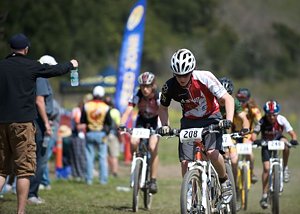 OAKLAND , CA – The Northern California High School Mountain Bike Racing League (NorCal League) will launch the Southern California Interscholastic Cycling League (SoCal League) in the 2009 academic year with grant support from the Easton Sports Development Foundation II.
OAKLAND , CA – The Northern California High School Mountain Bike Racing League (NorCal League) will launch the Southern California Interscholastic Cycling League (SoCal League) in the 2009 academic year with grant support from the Easton Sports Development Foundation II.


 So far, it’s clear that what some called a “lawless” atmosphere hasn’t entirely changed. Earlier last week, before the side trails reopened, evidence could be seen that the closure had not left the area to the lizards. Prints from hiking boots, hooves and tires marked dusty side trails. Hikers could be seen in off-limit areas of the reserve. At one juncture, a new trail sign had been shorn off at its base.
So far, it’s clear that what some called a “lawless” atmosphere hasn’t entirely changed. Earlier last week, before the side trails reopened, evidence could be seen that the closure had not left the area to the lizards. Prints from hiking boots, hooves and tires marked dusty side trails. Hikers could be seen in off-limit areas of the reserve. At one juncture, a new trail sign had been shorn off at its base.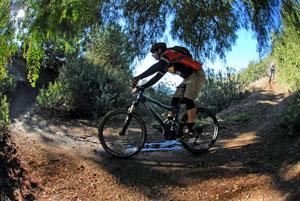 “If you’re exhilarated it ought to be from the scenery, not because you’re going fast,” Shaw said. “(Bikers) are not there for the primary purpose of the preserve, which is preservation of the flora and the fauna.”
“If you’re exhilarated it ought to be from the scenery, not because you’re going fast,” Shaw said. “(Bikers) are not there for the primary purpose of the preserve, which is preservation of the flora and the fauna.”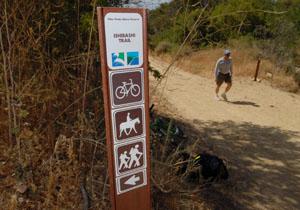



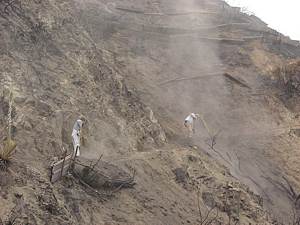 According to Pete Siberell, chairman of the Mt. Wilson Trail Race Committee, the work literally started while there were still fires on the mountain on Monday, April 28. A meeting of the Committee was held in Kersting Court, and the members resolved to get the trail ready in time to have the race go on as planned. “I received 15-20 calls and emails on that day from people who wanted to help,” said Siberell. “The first step was assessing the damage, which we did in short order right after the trail was closed. The majority of damage occurred in a stretch less than a mile-long, between the fire road just above the trailhead and the switchbacks just short of First Water.” While there is significant damage on the ridge to the east of the trail, the ridge on which the trail runs is relatively unscathed north of First Water up to Orchard Camp, 3.3 miles up from the foot of the Trail.
According to Pete Siberell, chairman of the Mt. Wilson Trail Race Committee, the work literally started while there were still fires on the mountain on Monday, April 28. A meeting of the Committee was held in Kersting Court, and the members resolved to get the trail ready in time to have the race go on as planned. “I received 15-20 calls and emails on that day from people who wanted to help,” said Siberell. “The first step was assessing the damage, which we did in short order right after the trail was closed. The majority of damage occurred in a stretch less than a mile-long, between the fire road just above the trailhead and the switchbacks just short of First Water.” While there is significant damage on the ridge to the east of the trail, the ridge on which the trail runs is relatively unscathed north of First Water up to Orchard Camp, 3.3 miles up from the foot of the Trail. Some volunteers worked on the trail during the day while it was still closed to the public, but many came after completing their work day at their jobs, arriving sometimes at 6pm or later and working for an hour and a half or two until the sun went down. A CORBA member who lives in Sierra Madre put together a volunteer team for last Saturday morning (May 10). With help and donations, he organized about 20 workers. The Department of Public Works lent tools, while the
Some volunteers worked on the trail during the day while it was still closed to the public, but many came after completing their work day at their jobs, arriving sometimes at 6pm or later and working for an hour and a half or two until the sun went down. A CORBA member who lives in Sierra Madre put together a volunteer team for last Saturday morning (May 10). With help and donations, he organized about 20 workers. The Department of Public Works lent tools, while the  May 9, 2008
May 9, 2008

 “The prices for boarding a horse are crazy,” said Rachel Rosenberg, 24, an aspiring actress who keeps her mustang, Indie, at
“The prices for boarding a horse are crazy,” said Rachel Rosenberg, 24, an aspiring actress who keeps her mustang, Indie, at  Registration Drives
Registration Drives
